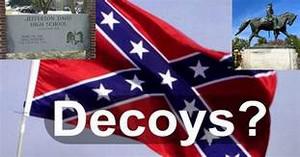Hate groupsSix months after Charlottesville: America’s white supremacists face challenges, opportunities
The 11 August 2017 Unite the Right event in Charlottesville, Virginia, brought white supremacists of all stripes together for a weekend of protest that turned to deadly violence. Six months later, what has happened to the far-flung and disparate groups that make up America’s white supremacist movement? Analysts say that for America’s white supremacist movement, the period since Charlottesville has been a time marked by seismic structural shifts and more than a few power struggles. Divisions have deepened, and the spirit of solidarity that animated the racist crowds in Charlottesville has long since dissipated. And yet, by some measures, evidence of white supremacist activism and engagement is more conspicuous than ever before.

Confederate memorial preservation a decoy for white supremacists // Source: yahoo.com
On 11 August 2017, the world watched in horror as hundreds of torch-wielding white supremacists descended on the University of Virginia’s bucolic campus, chanting, “Jews will not replace us!” The next day, the streets of Charlottesville exploded in violence, ringing with the hateful, racist shouts of the neo-Nazis, Klan members and alt right agitators who put aside their internecine differences to gather in an unprecedented show of unity. Their stated common cause: To protest the removal of a Confederate statue from a local park. Their true purpose: The preservation and celebration of the white race, at any cost.
The promise of Unite the Right brought white supremacists of all stripes together for a weekend of protest that turned to deadly violence, and left counter-protester Heather Heyer dead. The rally itself, which was organized primarily by Jason Kessler, an alt right activist with ties to notorious racist Richard Spencer, never actually happened. Instead, local and state police converged on the chaotic scene, urging everyone off the streets and away from the parks. Virginia Gov. Terry McAuliffe declared a state of emergency, and white supremacist leaders, from Richard Spencer to David Duke, while bemoaning the lost opportunity to address the crowd, declared the event an overall victory.
But was it a victory? Six months later, what has happened to the far-flung and disparate groups that make up America’s white supremacist movement?
The ADL says that for America’s white supremacist movement, the period since Charlottesville has been a time marked by seismic structural shifts and more than a few power struggles. Divisions have deepened, and the spirit of solidarity that animated the racist crowds in Charlottesville has long since dissipated. And yet, by some measures, evidence of white supremacist activism and engagement is more conspicuous than ever before.
